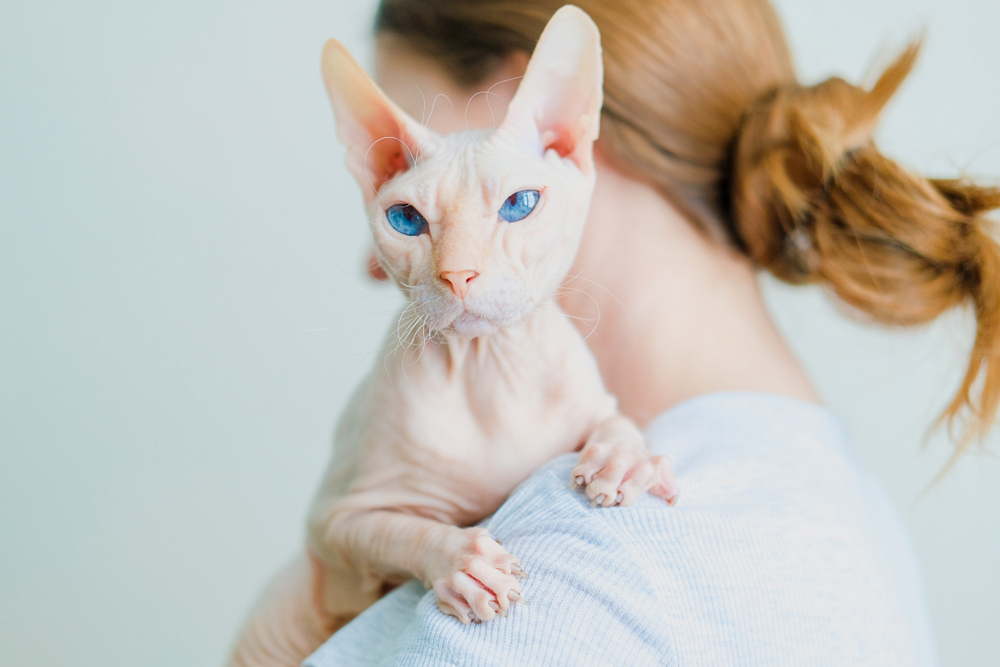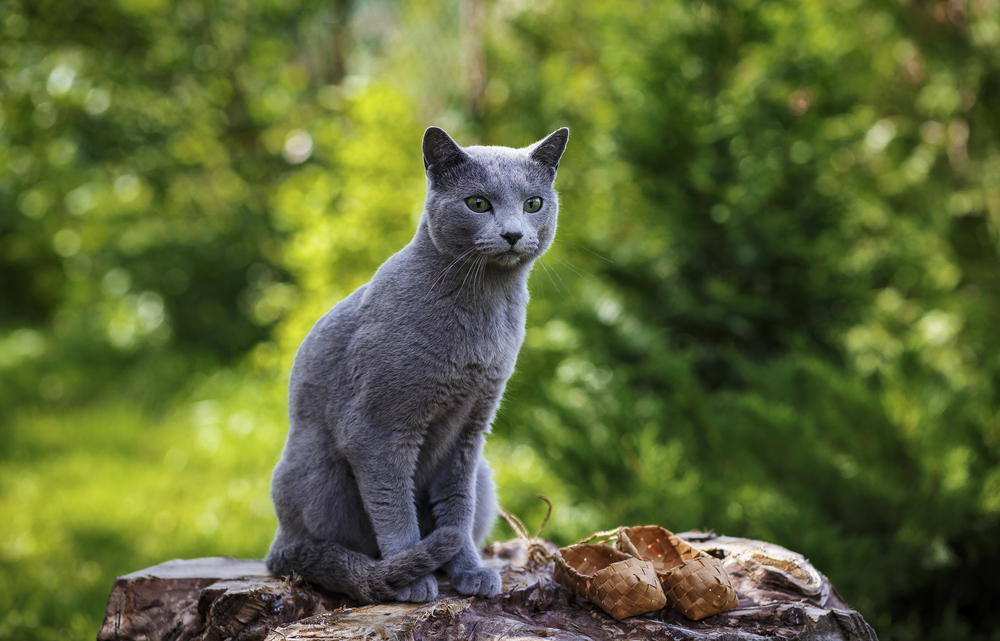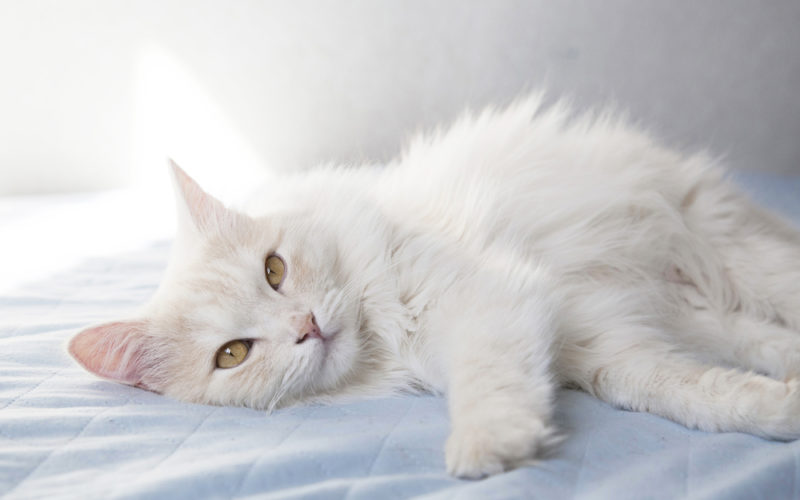If you’re looking for a cozy companion and don’t mind the odd water glass, flower pot, or cereal bowl knocked off of the counter, you might be the world’s next best cat parent.
When you adopt a cat, you’ll join a massive community—over 31.8 million people in the US cohabitate with at least one feline companion.1 But, most of those cat parents have one thing in common—they deal with cat hair piling atop their sofas, countertops, and favorite wool sweaters. You may notice that the shedding is more intense during specific seasons. Do cats or dogs shed more in the summer? It is possible that external conditions influence shedding.
Whether you have allergies or you simply don’t like vacuuming, this guide will break down a list of ten low-shed cat breeds that will steal your heart and explore everything you need to know about keeping your home shed-free, including incorporating CBD for cats into your fluffy friend’s wellness plan.
Are There Any Shed-Free Cats?
While plenty of hairless cats roam the world, truly non shedding cats simply don’t exist.2
That being said, all cat breeds commonly shed one or both of the following:
- Hair from their topcoat or undercoat
- Dander—dead skin flakes—which contain Fel d1, a common allergen3
Even hairless cats shed dander as old skin cells die, dry up, and flake off when they’re replaced by regenerating skin cells. So, if you’re looking for a truly shed-free feline experience, you’re out of luck.
But, there are some cat breeds that shed markedly less than their fur-depositing counterparts, helping pet owners with allergies or a distaste for lint rollers fulfill their cat-cuddling dreams without constant cleaning.
10 Low-Shed Cat Breeds
Let’s explore ten of the most popular low-shed cat breeds—whether they’re hairless or have very dense coats, the following breeds keep shedding to a minimum, but none are completely shedless.4
#1 Peterbald
Peterbald cats are slightly rare, but they offer some of the lowest shedding potential among housecats. But, don’t let their name mislead you—they’re not always completely hairless.
In fact, Peterbalds can have five different coat types, each one distinguishable from the rest:
- Hairless or with short, fine hair on their extremities only
- Full-body peach fuzz
- Downy, soft, short, and straight fur
- Wiry fur of varying lengths throughout the body
- Typical, full-body shorthair coat
While they’re an excellent low-shed choice for future cat parents, they can be difficult to find.
#2 LaPerm
LaPerms are the comedians of the cat world—they’re playful, clever, and mischievous, making them the perfect cat companions for families with children or pet parents who love cuddling on the couch.
While LaPerms have hair, their coats are relatively low-maintenance. Their hairs are soft and slightly curly, and even their light shedding can be reduced with regular brushing with a greyhound comb or slicker brush.
But, in your efforts to reduce your LePerm’s shedding, skip the blow dryer—weakening their soft hairs can lead to frizzing and more shedding than before.
#3 Sphinx
One of the world’s favorite cat breeds, the Sphinx is often considered to be hairless—however, Sphinxes are rarely completely hairless, often displaying:
- Full-body peach fuzz
- Fur on their face
- Hairs on the backs of their ears
While Sphinx cats are attractive for their relative lack of hair, they can be slightly high-maintenance. Vets recommend bathing them regularly to regulate their oil production and keep them clean since they don’t have a strong fur layer to keep dirt away from their skin.
#4 Cornish Rex
The Cornish Rex is a unique breed characterized by:
- Long, spindly legs
- Large ears
- Very short, curly coats
In fact, the Cornish Rex’s curls are so tight to their bodies that they can sometimes resemble corrugated metal—talk about washboard “abs.”
But, since their hairs are very short and the waves cling very closely to the skin, they don’t require much maintenance. They shed very little even without regular brushing or bathing.

#5 Bengal
Bengals are a fan favorite of the cat world—their rosette fur patterns resemble a jungle cat, they’re incredibly active, and they’re very tolerant of occasional cuddles.
Their short hair sheds infrequently, making them an excellent choice for cat lovers looking for a low-shed breed. Bengals are low-maintenance, but they do like space to roam, and you’ll likely become familiar with their animated screaming—err, vocalizing.
Bengals aren’t cats that don’t shed, but you can reduce their shedding even further with regular brushing and bathing.
#6 British Shorthair
British Shorthairs have soft, slate-grey coats with two unique features:
- A lack of undercoat, giving their fur a plush appearance
- Densely-packed hairs, which protect their skin and limit their shedding
Despite their striking appearance and low shedding profiles, British Shorthairs can be high-maintenance. In order to keep their dense hairs untangled and reduce shedding, British Shorthair parents should keep up with a routine brushing schedule to remove loose hairs, prevent matting, and evenly distribute their skin oils.
#7 Donskoy
If you like your pets to have unique features—or even a bit of an alienesque flair—the Donskoy might just become your new favorite breed.
While many resemble the Sphinx, the Donskoy can rock more than just a coat of peach fuzz. Some varieties sport unique characteristics, like:
- Full-body wrinkles
- Soft, wiry, and multi-length hair around their necks or on their tails
- Brightly-colored eyes
- Large ears
However, like their Sphinx relatives, Donskoys need to be pampered. They reproduce copious skin oils, so they should be wiped down daily to prevent oil buildup and keep dirt from collecting on their oily skin.
#8 Snowshoe
Long-time frontrunners for the Cutest Cat Award, the Snowshoe is a short-haired, soft, self-grooming kitty with a penchant for bathtime. While bathing cats is usually a delicate art, Snowshoes love water, and they won’t hesitate to jump in the bathtub with you.
While they groom themselves often, vets recommend semi-regular brushing to further reduce their (already very low) shedding.
#9 Chausie
Chausies are active, friendly, and outgoing—like Bengals, they share some visual similarities with big cats, including a short-haired coat that rarely sheds.
They’re also some of the most low-maintenance cats in the feline family. Chausie owners won’t have to worry about any of the following:
- Bathing
- Combing
- Detangling
- Clipping
The Chausie is the perfect cat for pet parents seeking an active, low-maintenance, low-shed furry friend.
#10 Russian Blue
The Russian Blue is a unique breed, and many aspects of their skin and hair are attractive to potential cat parents:
- They have silky, dense double-coated fur
- They only shed over a two-to-three week period once or twice each year
- They produce lower levels of Fel d1 than other cats, reducing their allergen potential
While the other breeds on this list shed minimally year-round, Russian Blue parents will have to tolerate and manage a fur purge at least once a year. But, if you don’t mind a short period of daily vacuuming and brushing in exchange for multiple shed-free months, a Russian Blue should top your shortlist.

Tips for Cats that Shed
If you welcome one of the above cats to the family, you’re still likely to encounter some shedding. But, you can take steps to further reduce these low-shed cats’ hair loss potential.
#1 Brush More Frequently
Regular brushing is one of the best ways to combat shedding—for dogs and cats. Brushing is a useful tool for pet hair management for two significant reasons:
- Brushing dislodges weak, loose hairs that are ready to fall out. By collecting them in a hairbrush or comb, you can prevent them from littering your floors, furniture, and surfaces.
- Brushing gives you an opportunity to search for underlying causes of hair loss. If your cat is shedding more than usual, an underlying injury could be to blame. While you brush your cat, keep a close eye out for scratches, rashes, irritation, or sunburn.
#2 Visit Your Vet
Speaking of underlying causes, cat parents should visit their vet if they suspect unusually high shedding or hair loss. You should do the same if your dog is shedding a lot as well.
While excess shedding is usually benign, it can be a warning sign that your cat is healing from an undiagnosed condition, like:5
- Food, environmental, or medication allergies
- Bacterial, viral, or parasitic infections
- Arthritis (cats commonly lick themselves on arthritic pain points, leading to hair loss)
- Anxiety or stress
While these can sound like daunting issues, your vet can help you identify and treat any of the above conditions, improving your cat’s comfort level and helping them return to regular shedding patterns. When in doubt, you can always call your vet for advice.
#3 Add CBD to Your Pet’s Nutrition Plan
Shedding is a perfectly natural biological process for cats—but, if they’re suffering from an underlying condition like any of the ones listed in the previous section, it could increase their shedding capacity.
After visiting your vet, consider adding a CBD supplement to your cat’s diet—while CBD research is still ongoing, early research suggests that CBD may relieve redness and discomfort and may also help to soothe feelings of stress.6
Fortunately, CBD isn’t psychoactive, but it does stimulate the endocannabinoid system (ECS), a bodily process that all mammals possess. The ECS works with mammals’ central nervous systems to regulate cell reception and other critical nerve functions that impact stimulus response in the body.7
By stimulating the ECS with CBD, your cat may benefit from the cannabinoid’s health-supporting properties, increasing your cat’s comfort level while they recover from a shed-inducing condition.
Canna-Pet: Supporting Pet Wellness for Decades
While adopting a completely shed-free cat isn’t possible—even for those striking “hairless” breeds—you can prioritize low-shed breeds and take steps to prevent shedding.
Whether your cat companion is a big-time shedder or mostly keeps their hairs to themselves, Canna-Pet is here to help you meet your cat wellness goals with high-quality, organic CBD products.
We’re a global pioneer of CBD for pets, bringing this potentially powerful healing compound into the public eye and into the homes of pet lovers everywhere. Our CBD products are the result of over thirty years of research, and we’re leading the charge in cannabinoid health research to improve the quality of life for pets everywhere.
Our products are safe, natural, and delicious—everything you want in a pet supplement.
Sources:
- American Veterinary Medical Association. US Pet Ownership Statistics. https://www.avma.org/resources-tools/reports-statistics/us-pet-ownership-statistics
- Purina. Cat Breeds that Don’t Shed. https://www.purina.com/cats/cat-breeds/collections/cat-breeds-that-dont-shed
- BondVet. The Cat Breeds That Shed the Least. https://bondvet.com/b/cat-breeds-shed-the-least
- Newsweek. 20 Cat Breeds That Shed the Least. https://www.newsweek.com/cat-breeds-that-shed-least-1606314
- Fetch by WebMD. Why Do Cats Lose Hair?. https://pets.webmd.com/cats/diseases-hair-loss-cats
- Harvard Medical School. Cannabidiol (CBD) – What We Know and What We Don’t. https://www.health.harvard.edu/blog/cannabidiol-cbd-what-we-know-and-what-we-dont-2018082414476
- National Library of Medicine. An Introduction to the Endogenous Cannabinoid System. https://www.ncbi.nlm.nih.gov/pmc/articles/PMC4789136/



